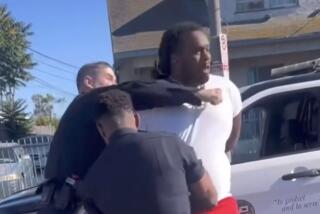Crisis in Los Angeles Policing: Reform Is the Only Way Out
- Share via
Policing is a basic function of government--a service that is at the very center of its reason for being. When government cannot deliver that basic service properly, the specter of societal chaos looms and the credibility of government itself is called into question. At the moment Los Angeles faces precisely that situation. It finds itself in an across-the-board policing crisis.
As fate would have it, both the Sheriff’s Department--the countywide police agency of 8,000 officers--and the Los Angeles Police Department--of 8,450 officers--are in great trouble and turmoil. These two large police bureaucracies represent a very substantial amount of all the policing that is done here. And both agencies are under fire. Whatever the actual merits of the various criticisms leveled at these two large police forces, it must be asked how Los Angeles could have come to this.
1. The Question of Oversight: Neither the Sheriff’s Department nor the LAPD serves any master other than itself. In the vast sea of county and city government, they are distinct anomalies--each in its own way. This is the structural origin of the problem: In effect neither agency has a real boss.
The sheriff--the top official of the department--faces the voters every four years and thus, along with the five members of the Board of Supervisors, is one of the county’s top elected officials. With a countywide electoral base (the supervisors are each elected from one of five supervisorial districts) the sheriff in effect reports to no one for four years, after which time he returns to the voters for re-election; incumbent sheriffs, like most incumbents, routinely are returned to office by a shrinking percentage of eligible voters. The Board of Supervisors does exercise a measure of budgetary oversight, but it is a rare supervisor who will challenge a sheriff in any substantial way and risk offending one in charge of vital law enforcement services.
The Los Angeles police chief is an appointed official who, once in office, is virtually impossible to remove. Key reforms proposed by the Christopher Commission are designed to correct a deficiency that has enabled the department to operate largely above politics--which is desirable--but also without substantive, ongoing accountability to any civilian authority--which is not desirable. The Police Commission, in theory the overseeing body, has been virtually without clout and staff; and the City Council, in theory the ultimate civilian authority, had done a very poor job indeed of holding the LAPD accountable. Again, among council members, few want to risk angering a powerful police chief.
2. The Question of Isolation: In respect to their attitude toward the public, both police agencies are probably more alike than dissimilar. Theirs is not so much the attitude of servants of the people as masters of law and order. Institutionally they stand above and apart, and this leads to an attitude of institutional superiority. That attitude shows through in their oft-revealed contempt for minorities, and their occasionally revealed contempt for politicians.
Los Angeles’ isolated police culture no doubt derives in part from the difficulty of policing Los Angeles. It is a truly monstrous job (uniquely spread out) and increasingly diverse (two overwhelmingly white police agencies sit on top a decreasingly white population). Overlapping municipal and county jurisdictions lead to political gridlock, and inept politicians add to the problems. But it is the deeply embedded alienation of the police from the people that is dangerous. It can’t be allowed to continue.
3. The Question of Attitude: Community policing is an oft-touted reform--advanced by many experts around the country and embraced wholeheartedly by the Christopher Commission. Indeed, Sheriff Sherman Block has said that the commission’s proposals for the LAPD might in large measure apply to his agency. The idea of community policing has some puzzled. It shouldn’t: Community policing is not rocket-science stuff. It’s not a panacea but a proclivity. The approach’s proclivity is to emphasize prevention over reaction, neighborhood alliances over flashy elite units, a sustained presence in the community over what some experts have called “stranger policing.” The Christopher Commission was dead right to commend it to Los Angeles’ attention. More than anything else, the adoption of community policing would represent a much-needed attitude adjustment.
4. The Question of Race: This place is no longer what it once was, if it ever was remotely similar to the fantasy of a sprawling version of the Beverly Hills Hotel. In the city there are now more Latinos than Anglos, and almost as many Asians and Pacific Islanders as African-Americans. As writer John Gregory Dunne pointed out in his superb two-part article “Law and Disorder in L.A.” in the New York Review of Books, in 1990 the most common name given to a male child was . . . Jose.
This is the society both the Sheriff’s Department and the LAPD are asked to police. Are these deeply entrenched bureaucracies up to the task? That is the crucial question.
5. The Question of Crime: Statistics can be made to mislead, and it is possible to make the statistical case that the streets of Los Angeles are barely more dangerous today than 10 or 20 years ago. But common sense and intuition argue, powerfully, against that notion; so does the widespread prevalence of high-powered rifles and handguns on the street.
Thus to the historical isolation of L.A. police now add the violence of our gun culture. Add also the alienation of some of our communities--the growing bitterness, desperation and anger. Then add the need for professionally and thoroughly reforming our two local police agencies, and all this becomes a matter of immense urgency. This generation of Angelenos owes it to the next to straighten this problem out.
More to Read
Sign up for Essential California
The most important California stories and recommendations in your inbox every morning.
You may occasionally receive promotional content from the Los Angeles Times.













